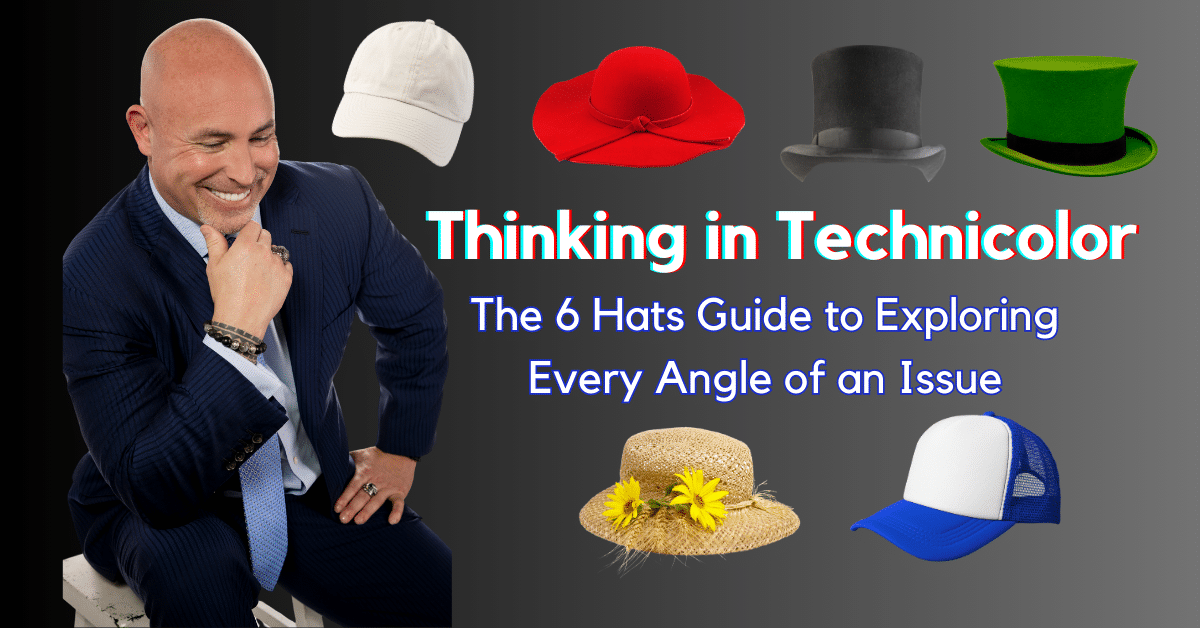Have you ever sat through a meeting that felt frustratingly circular?
People rehash the same points, get lost arguing emotions instead of facts, or fail to generate any fresh ideas.
Meanwhile, the clock ticks and you leave without making a decision.
Edward de Bono felt your pain.
That’s why the lateral thinking legend invented the “Six Thinking Hats” technique.
By assigning each style of thinking a colored hat and taking turns “wearing” them, teams can vastly improve their decision-making.
Each hat represents a distinct thinking mode, allowing you to approach problems and ideas from fresh angles.
For the purpose of the experiment, each team member is only allowed to wear one hat, thereby focusing on one perspective.
White Hat: Just the Facts
The emotionless white hat collects objective information. The team member donning the white hat has to set feelings aside and stick to the data at hand.
The objective white hat is all about looking at information objectively without any interpretation or emotion. When you put on the metaphorical white thinking hat, you examine the available data and facts without considering feelings, opinions, or judgments.
Some key aspects of donning the white hat:
- Sticks to available statistical data like numbers and dates
- Focuses just on observable or measurable details
- Looks at relevant information only, ignoring interpretations
- Describes and summarizes without categorizing as positive or negative
While white hat thinking is helpful for getting baseline factual knowledge, decisions require other perspectives as well.
Reviewing the black-and-white facts is often a solid starting point before exploring other modes of thinking.
Red Hat: Speak from the Heart
The fiery red hat allows people to share emotional reactions, intuitions, and feelings about an idea without needing explanations or justification.
When the red hat is on, the discussion operates on passion and instinct rather than cold hard logic.
Some examples of what happens when the red hat comes on:
- People can explain why an idea leaves them with a positive or negative gut feeling even if they can’t rationally defend why they feel that way.
- You can point out potential issues or flaws in an idea that rub you the wrong way without specifics or data to back up your perspective.
- Participants are free to share sentiments like excitement, anger, unease, or satisfaction about an idea or decision without questioning from the group.
- Discussion tends to be more personal story-based and experiential vs analytical. You can explain why something does or doesn’t resonate with you based on personal history.
The key benefit of the red hat is it gives equal weight to emotional perspectives instead of dismissing feelings as irrational.
This allows valuable insights from experience and intuition to surface that could get overlooked by purely logical debate. It also lets participants air doubts or negativity in a productive way.
Green Hat: Crazy Ideas Welcome
The vivid green hat represents creativity, possibilities, and new ideas. Putting on the green hat signals it’s time to brainstorm inventive solutions and fresh perspectives without limits or judgment.
When the green hat comes on, the discussion tends to go in these type of directions:
- People think freely and wildly, saying whatever pops into their minds relevant to the topic.
- Strange ideas, offbeat suggestions, and unconventional proposals are welcomed and built upon.
- The focus stretches beyond what exists to what could exist with enough creativity and re-imagination.
- Humor and playfulness abound as inhibitions fade away. The sillier the better during a green hat jam session!
The green hat provides crucial space for innovation, and paradigm shifts that logical thinking struggles to come up with.
Removing filters by giving permission to be wildly impractical with ideas is where some genius concepts emerge, even if they need refinement later.
Black Hat: Risky Business
The cautious black hat allows the wearer to play devil’s advocate, spot potential weaknesses, and raise concerns about an idea without being seen as overtly negative. Donning the black hat gives participants the license to explore what could go wrong with a potential decision.
Some examples of what happens when someone puts on the black hat:
- They can point out flaws and risks in a proposal without needing to justify a positive counter-proposal.
- People can question assumptions being made or details being overlooked without seeming like a naysayer.
- The discussion focuses on worst-case scenarios, obstacles, and things that might not go as planned.
- Those wearing the black hats look for weak spots in an argument, inconsistent data, and unintended consequences.
- The mood may seem discouraging, but the purpose is to strengthen strategies by accounting for misgivings.
The black hat thinking style is about applying strategic skepticism rather than shooting down ideas prematurely.
It allows people to dig into doubts that might otherwise get minimized with positivity bias. Removing social pressure to be positive lets issues surface so they can be addressed.
Yellow Hat: Feel the Optimism
The sunny yellow hat provides a dose of positivity to offset potential weaknesses and risks. Putting on the yellow hat allows participants to explore the potential benefits, upside, and positive outcomes of a decision being considered.
Some examples of what happens when the yellow hat comes on:
- People focus on exploring the best-case scenario of how things can play out if a decision is made or a plan is implemented.
- Discussion centers around why an idea could feasibly work and the potential rewards it offers.
- Your thinking aligns with the “glass is half full” view as you demonstrate enthusiasm and agreeableness.
- Instead of evidence, hopeful assumptions carry the arguments about the possibilities of what can go right.
The yellow hat is useful directly after some black hat skepticism to restore constructive vibes.
It ensures potential issues don’t cloud thinking about the viable ways a decision could actually have tremendous advantage.
Blue Hat: Eyes on the Prize
The composed blue hat takes a big picture view by focusing on process, organization of thinking, and drawing conclusions. Putting on the blue hat designates someone as the meta-thinker focused on ensuring clear and productive discussion to ultimately get to final decisions.
When a participant puts on the blue hat, they focus on:
- Defining the goal or objectives of a session before diving into debate
- Summarizing different ideas and bringing together diverging trains of thought
- Identifying gaps in information needed to make conclusions
- Asking guiding questions to steer the dialogue toward resolutions
- Determining next steps and clarify what final decisions have been made
The blue hat requires reflecting carefully on how effectively the group is processing complex issues while others are caught up discussing specifics.
Blue-hat thinking ensures a balanced and comprehensive analysis.
Six thinking hats assignments create a diversity of perspectives while avoiding mental fatigue from constant context switching.
When specific participants wear the same hat all through the session, they can deeply explore that dimension, leading to richer input.
For example, you may designate a few team skeptics to point out flaws while unleashing the wild creativity of your resident dreamers to riff on novel solutions.
Rotating hats between the six thinking hats so that optimism follows pessimism prevents getting emotionally stuck and stimulates jumps to new levels of understanding.
As conclusions emerge, the blue hat coordinators from each small group can converge to combine mental models and determine unified next action steps.
You fast-track synthesis by tagging participants as fact-finders, crazy creatives, pragmatic doubters, strategizers, and other thinking types.
So if your last few meetings feel more like a ride on the tea cups at Coney Island, try the 6 hats approach.
Respectfully highlight the diversity of thinking in your team and leverage it for best results.
Give it a try – at minimum, hats off to you for trying something new!

